 USA (1912) USS New York, Texas
USA (1912) USS New York, TexasWW1 US Battleships:
USS Maine | USS Texas | Indiana class | USS Iowa | Kearsage class | Illinois class | Maine class | Virginia class | Connecticut class | Mississippi class | South Carolina class | Delaware class | Florida class | Arkansas class | New York class | Nevada class | Pennsylvania class | New Mexico class | Tennessee class | Colorado class | South Dakota class | Lexington classThe New York class became the first American battleships with 14-in guns and the last with coal, twin turrets, no AA and classic 1900s scheme protection.
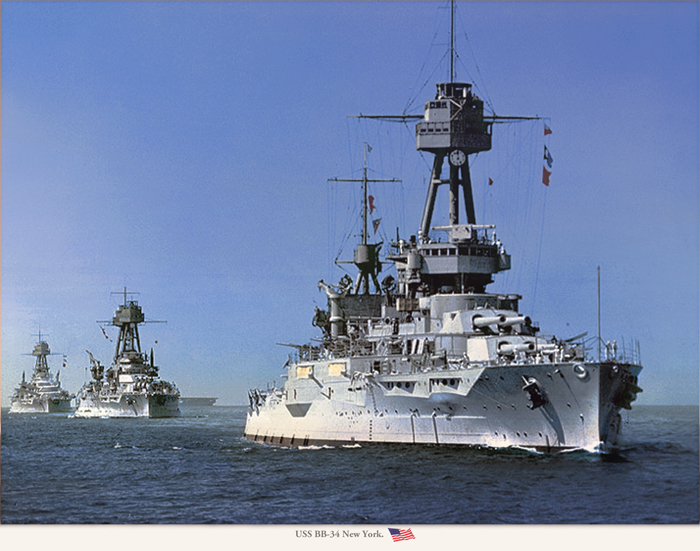
BB34 New York after the 1926 refit. Behind her, BBs of the Nevada class. Note the livery of the time, light grey for the hull and superstructures up to a point and dark grey above. Colorized by Irootoko Jr.
Faithful to the incremental process in designing battleships, the admiralty decided to upgrade the artillery for the next batch. It was decided notably to the light or rapid progresses in Europe: The new standard became 14 in after the Orion class was announced in construction already in 1909. However, this innovation was a bit hampered by the fact these ships kept a five twin-turret axial layout and coal-fired boilers.
Deficiencies were noted at a time aviation became a thing, having no anti-aircraft armament whatsoever, whereas the armor layout still let to be desired. All these issues were fixed on the next generation, the revolutionary ‘standard’ battleships of the Nevada class. Several extensive overhauls however, let both battleships participating to WW2, until V-Day, on the Atlantic, Mediterranean and Pacific fronts.
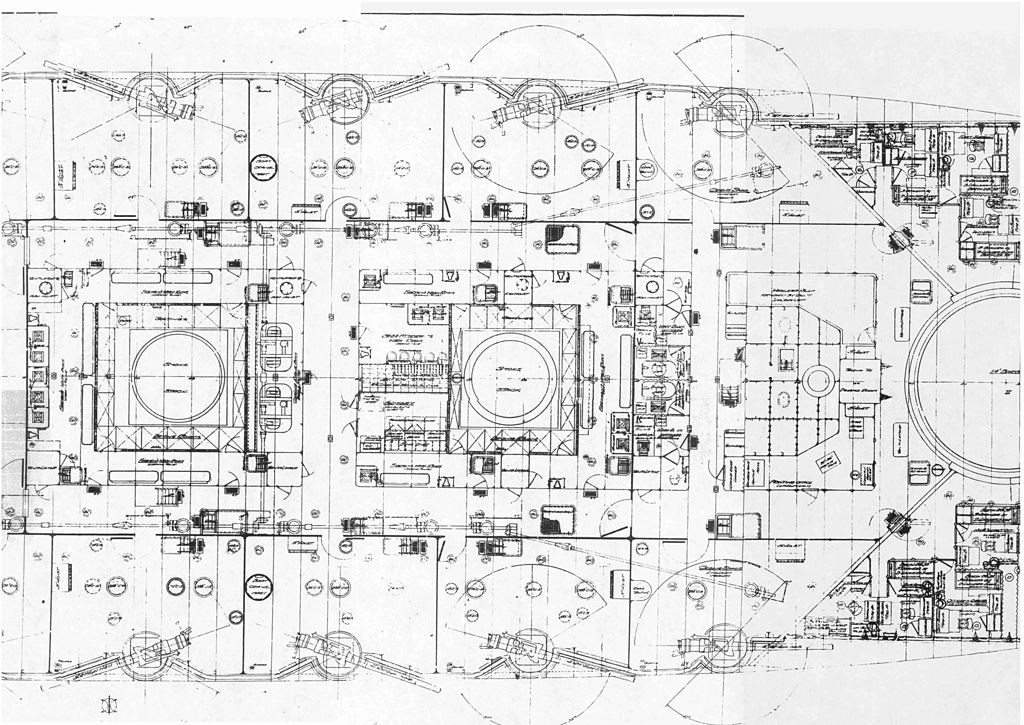
Detailed plans of the ship, casemate section and forward deck sections – Blueprints are available in open source
Design of The New York class
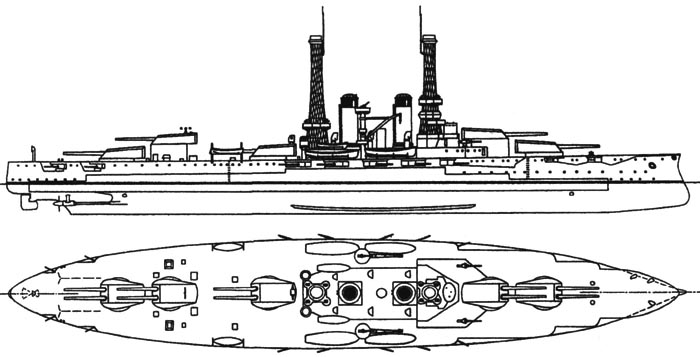
General overview of the BB34 class in 1918 – Src the blueprints
The design of the New York-class originated in the 1908 Newport Conference: It fixed a new method for battleship design, with the General Board taking more implicated in the design process, the navy’s Board on Construction swapping to the role of making it practical for construction. The New York class design therefore was the last to come from the Board of Construction (BoC), and therefore this in reaction made the next time the General Board to take the lead and design the much better Nevada-class battleships.
The Newport Conference ended also with conclusions such as the requirement of larger batteries in reaction of foreign British BL 13.5 inch Mk V being introduced and German Navy’s shift to 30.5-centimetre (12 in) guns. Already it was thought to upgrade the Florida-class laid down in 1909 but 30 March 1909 this was curtailed by the US Congress which approved the more reasonable “Design 601” or “Battleship 1910” armed with six 12-inch turrets favored by the BoC over the General Board’s choice of two 14-inch designs in 1909.
The Wyoming class started left the General Board planning planning for the next design on 21 April 1909, with a similar size to make it more acceptable to the congress whereas the gun upgrade was only obtained on 24 June 1910.
However in 1911 the US Senate’s Naval Affairs Committee had to comply to a $24,000,000 budget reduction, and suggested to reduce their tonnage but this was opposed but Secretary of the Navy George von Lengerke Meyer which strongly opposed it. The New York class is sometimes referred to by some authors as the Texas class due to the later completion of the New York.
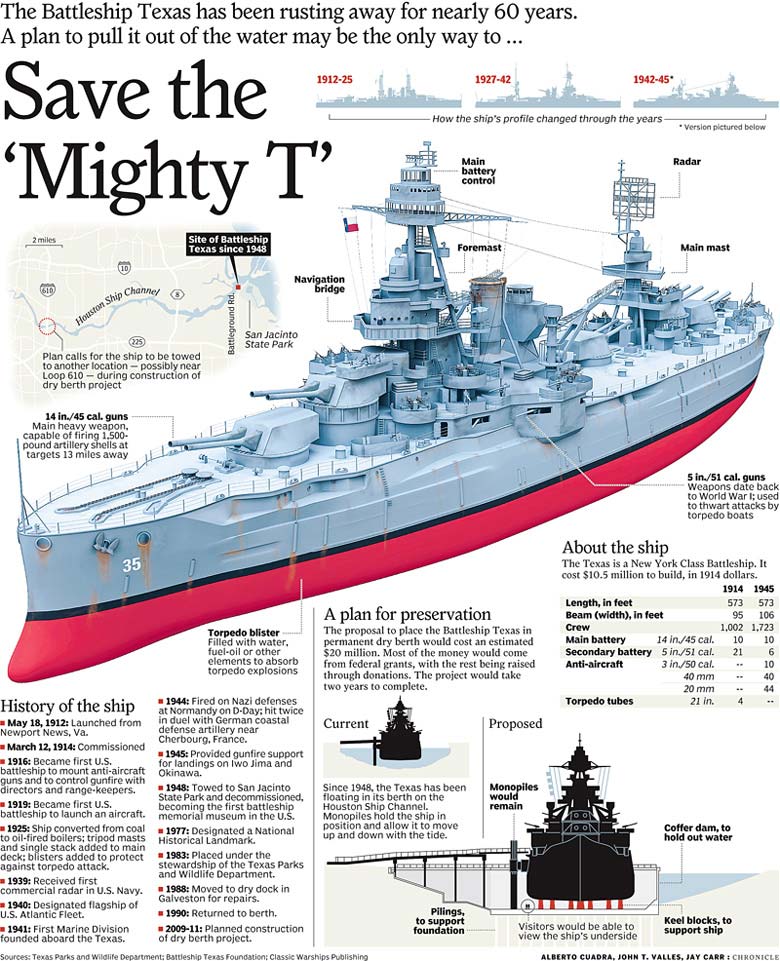
Extract of an article from classic battleships about the Texas and measures to preserve her.
Armament
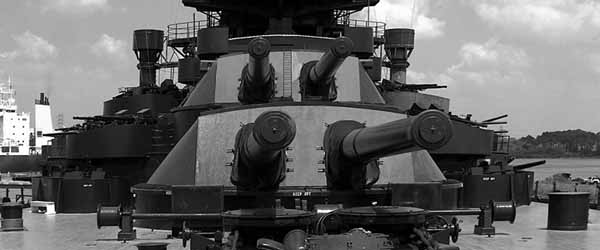
Main artillery: 10x 14-in/45 (356 mm)
The main artillery of the New York class consisted in ten 14-inch/45 caliber guns, in five axial twin turrets. Their mounts made them able to elevate to 15°. Still, there was a turret mounted amidships, and this was the last class to do this. From then on, all USN Battleships will have four superfiring turrets for an aft, the famous standard.
In 1910 the US Navy’s Bureau of Ordnance (BuOrd) successfully tested the 14-inch naval gun, which was noted for its excellent accuracy and a remarkable ballistic regularity over time.
Secondary artillery: 21x 5-in/51 (127 mm)
The secondary guns were placed along the side (ten each), plus a single last one in the stern. It was placed there to complete the classic “dead angle” against closing-in destroyers and torpedo boats. These 5-inch guns however would prove having a poor accuracy in rough seas of course due to water splashed masking the observers in particular for those below the main deck level aft.
Tertiary artillery: 2x 3-in/50 (76 mm)
Although AA defense was not in the design plans, 1910 saw interesting developments in pioneering naval aviation, and therefore the New York class was the first to mount anti-aircraft guns, at the time two regular 3-inch (76 mm)/50 caliber with great angle mount. To give them maximal arc of fire, they were placed on platforms on top of the boat cranes. This was tried on USS Texas in 1916.
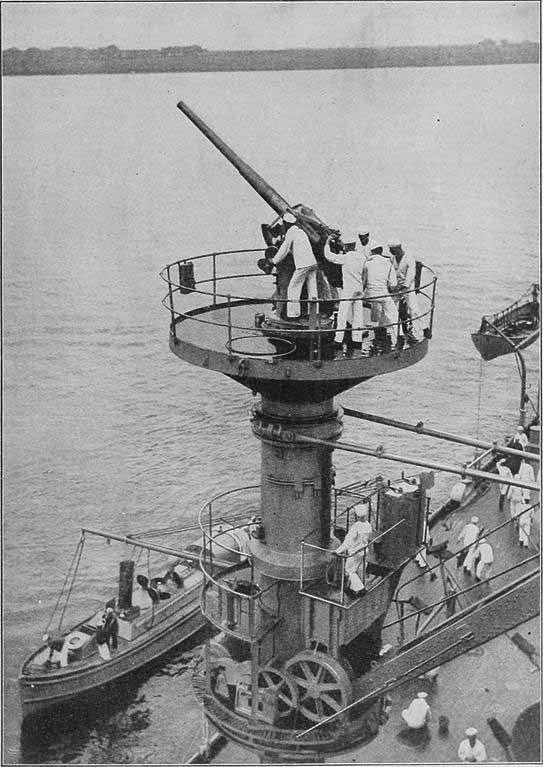
3-in gun on a crane platform onboard USS Texas
Close-in defence: 4x 21-in TTs (553 mm)
The New York class design included four torpedo tubes: They covered all both sides, plus the bow and stern. They fired a single Bliss-Leavitt Mark 3 torpedo each, without ready reload. Indeed this model was trusted enough to do the job. However there was a centralized torpedo room for extra 12 torpedoes and 12 naval mines thant could be launched by the same system, converting the battleships as minelayers. Of course these fetures were largely seen as obsolete in the interwar and they were removed during the major 1925-26 refit.
Wartime modifications
In 1918, the inefficient low-slung 5-in secondary guns were curtailed to just 16, eight per broadside.
Interwar modifications: 1926
During the great reconstruction of 1925–26, AA defense was increased: Eight 3-inch/50 cal. four per side on the main deck. However at the same time, six of the 16 5-inch guns were relocated in new casemates over the main deck, protecting them in heavy weather.
Also the Magazine and machinery spaces were better included in the protected hull. Due to the new increased machinery, the magazine space was reduced, down to 75-80 shells and charges, while extra shells were stored in the turrets and handling rooms. The enquiry of the battlecruisers loss at the battle of jutland was not a thing then.
Interwar modifications: 1937
In 1937, two quadruple “Chicago Piano” 1.1-inch (28 mm)/75 caliber AA guns were added in complement to the slow-firing 3-in guns.
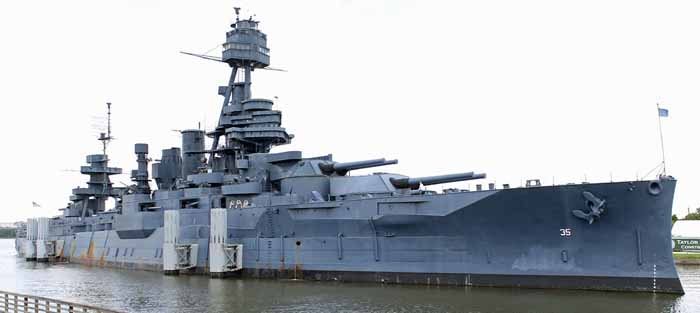
WW2 modifications
After 1941, the quad “Chicago Piano” 28 mm were removed, replaced by 24 Bofors 40 mm guns (six quadruple mounts) and past 1944 40 guns (10 x 4), plus forty-two Oerlikon 20 mm guns in single mounts. The 3-inch AA gun was not removed by at the contrary increased to ten guns. To save weight and ammo space, only six 5-in secondary guns were left in the casemates, three either side. The ships were comprehensively rearmed in 1942 and 1944, but not reconstructed (like the adoption of the new twin 5-in AA turrets).
Protection
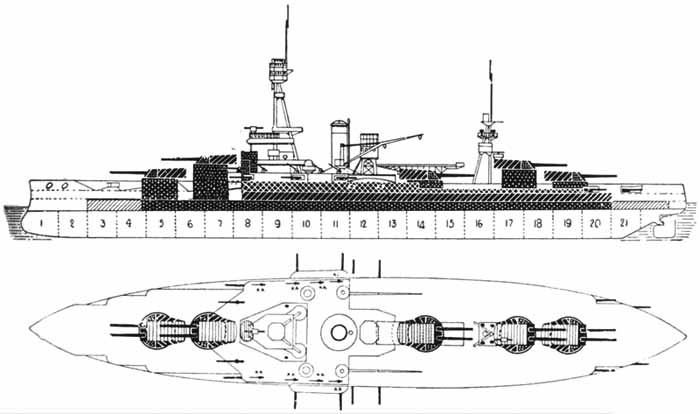
The armor scheme of the previous Wyoming class was reconducted, with just some minor improvements. The deck armor was uniform, not adopting the all or nothing armor scheme and with poor characteristics against high angle ballistics. Improved fire control would change the game so quickly that it negated this kind of armour in 1913 already, and was not embedded yet in the New York class design.
There 6.5 in (165 mm) internal casemate armor had some internal bulkheads. However the true innovation came from an armored central plotting room, below decks and atop the protective deck. It was enclosed in a “box” of splinter armor and protected the operators, vital for the Fire control systems of the ship.
The lower casemate armoured range from 9 in (229 mm) to 11 in (279 mm), with an upper casemate 6 in (152 mm) strong. The Deck protection consisted in a 2 in (51 mm) thick main deck. Main turret faces were given 14 inch armour, down to 4 in (102 mm) on top and 2 in (40 mm) for its sides and 8 in (203 mm) on the back plate.
The main turret barbettes barbettes ranged from 10 to 12 inches, like the belt. The two conning towers, forward and aft, had 12 inches thick walls with roodfs 4-in thick. The total weight of the armor on the New York and Texas was about 8,120.62 t (7,992.37 long tons; 8,951.45 short tons) of extra hardened steel, the weight of a cruiser. This was consistent with figures noted on foreign contemporary designs.
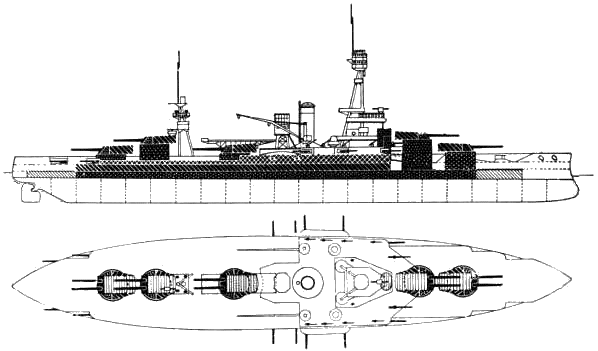
Propulsion
There was nothing new in this chapter. The previous Wyoming class scheme was reproduced. The USS New York and Texas propulsion system would rest on two dual-acting triple expansion reciprocating steam engines, not turbines. They were fed by fourteen Babcock & Wilcox coal-fired boilers. Total output was 28,100 shp (20,954 kW). This resulted in a top speed of 21 knots, still (39 km/h; 24 mph). Fortunately, this class was the last to use coal, and steam turbines were gradually tested.
The New York class range was about 7,060 nmi (8,120 mi; 13,080 km) at the cruise speed of 10 knots (19 km/h; 12 mph).It as at first advocated a 14% increase in output (32,000 shp/24,000 kW) to reach the required 21 knots, but it appeared that by just working out boilers/VTE efficiency, 28,100 shp were just what was needed to reeach the design speed.
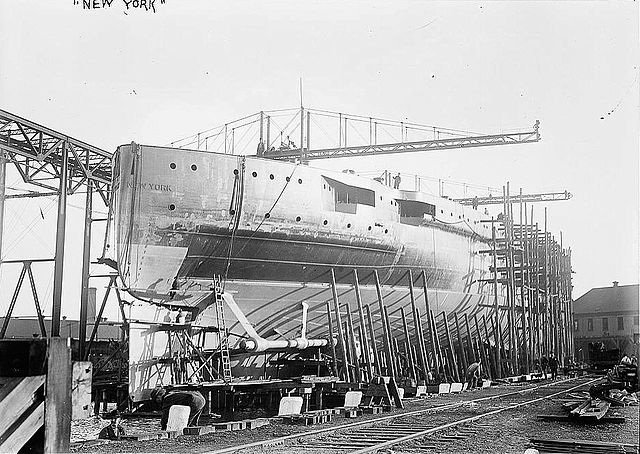
USS New York in construction at Brooklyn Navy Yard, mid-1912.
1926 machinery upgrade
As designed, 2,850 long tons (2,900 t) of coal were carried, most than any previous class. Of course the next Nevada carried oil which took less space and had greater range. Oil conversion was made by replacing all 14 boilers by six new Bureau Express oil-fired models in 1926. The tanks were rebuilt to carry oil, squeezing 5,200 long tons (5,300 t), almost twice the capacity.
The 1925-26 refit did not affected only the armament and powerplant, but also the general appearance of the ship and fire control system. The truncated funnels of the new boilers ended with a single funnel, placed in between where were the former two, behind a completely reconstructed bridge tower. Indeed the cage masts were removed, and solid tripods built in their place. A tall one to support the bridge and its dependencies, and a new fire control, direction and admiral deck on top, and a second tower and aft direction center on the shorter tripod aft. The appearance of the ships was considerably changed and stayed that way with only AA and radars additions until their decommission.
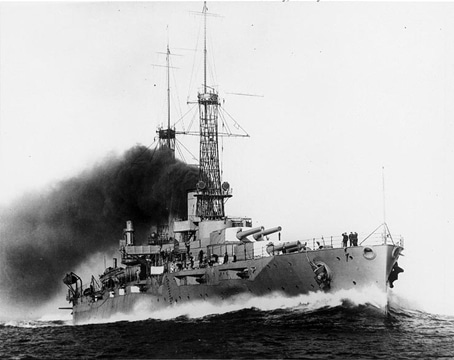
USS New York entering service in 1915
Specifications in 1914 |
|
| Dimensions | 175 x 29 x 9 m – 573 ft, 95 ft, 29 ft |
| Displacement | 27,000 long tons standard, 28,367 long tons Fully Loaded |
| Crew | 1044 total |
| Propulsion | 2 shafts VTE 14 water-tube boilers 28,100 shp (20,954 kW) |
| Speed | 21 kn (39 km/h; 24 mph) 7,060 nmi (13,080 km; 8,120 mi) |
| Armament | 10 × 14in (356), 21 × 5in (127), 4x 3pdr, 2x 1pdr, 2x 21in (533 mm) TTs sub |
| Armor | Belt: 10–12 in, casemate: 6.5–11 in, Barbettes: 10–12 in, Turrets 2-14 in, Decks 2 in, CT 12 in |

USS New York – NARA
Specifications (Texas) in WW2 |
|
| Dimensions | Same but width beam 32.3 m (106 feets) |
| Displacement | 32,000 – 33,000 tons FL after refit 1926 |
| Propulsion | 6 × Bureau Express oil-fired boilers |
| Speed | 19.72 kn (23 mph; 37 km/h) |
| Armament | Main (same) 6× 5 in/51, 10× 3 in/50, 10× quad 40 mm Bofors, 44× 20 mm Oerlikon |
| Armor | Same but turrets top extra 1.75 in (44 mm) |
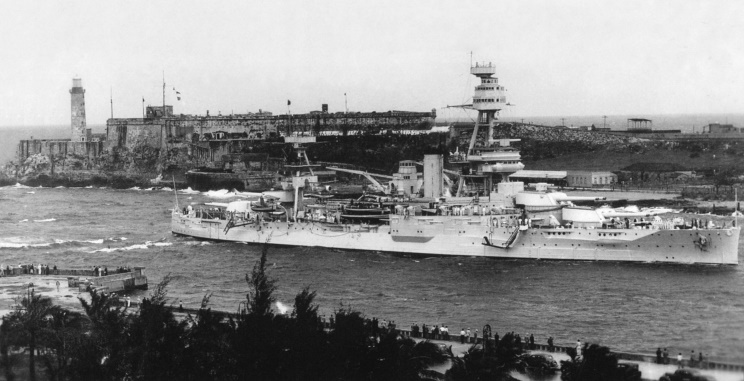
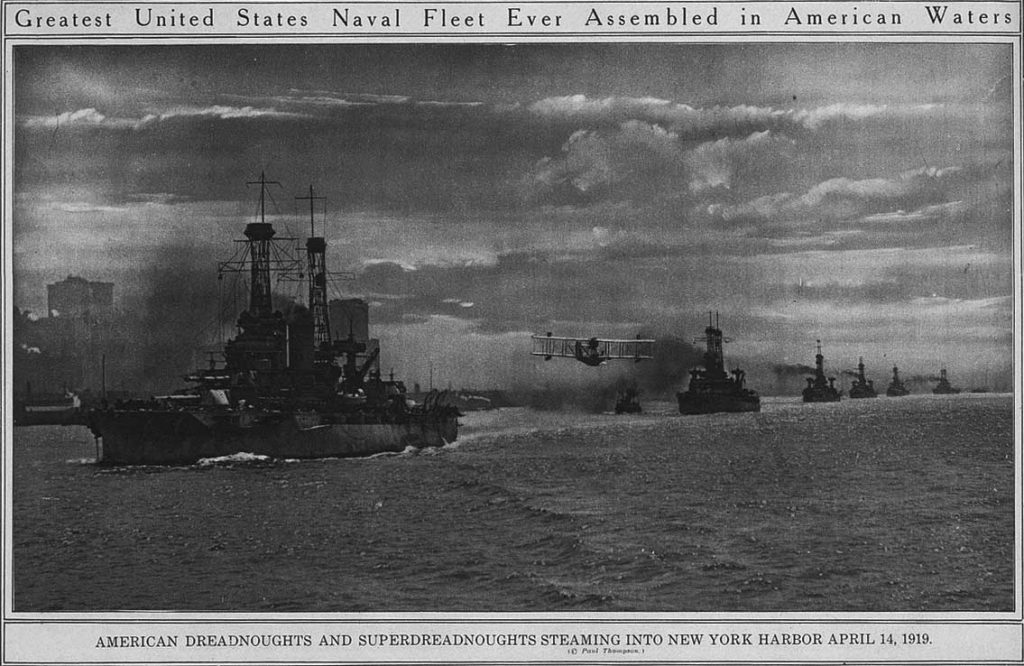
USN fleet assembled in front of NYC for a parade, 1919
Illustrations and other renditions

USS New York as built

USS New York in 1918

USS New York in 1942 – author’s illustrations
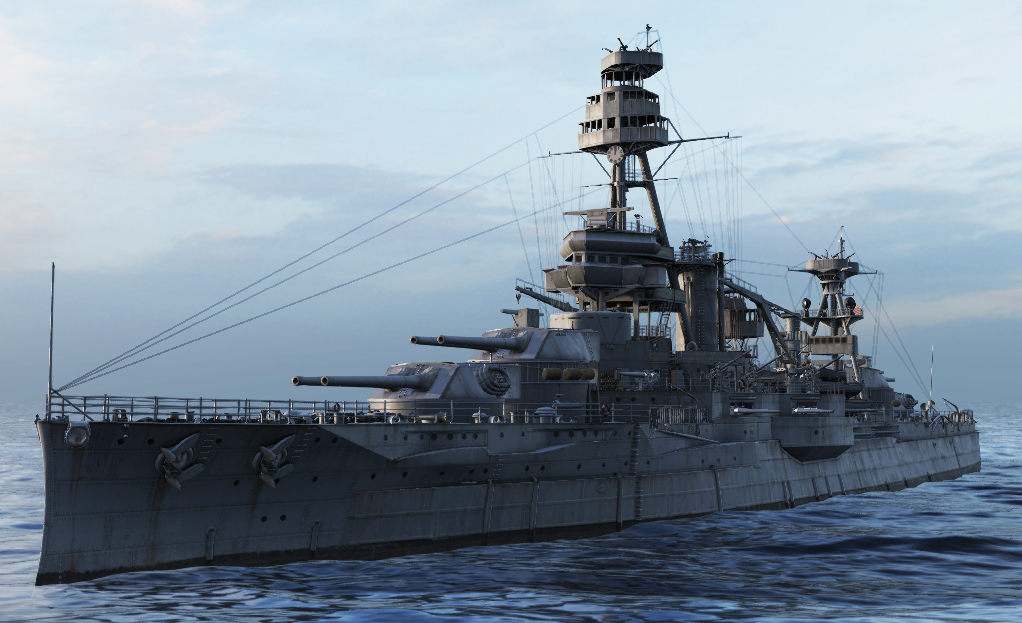
Wow’s rendition of the New York after refit.
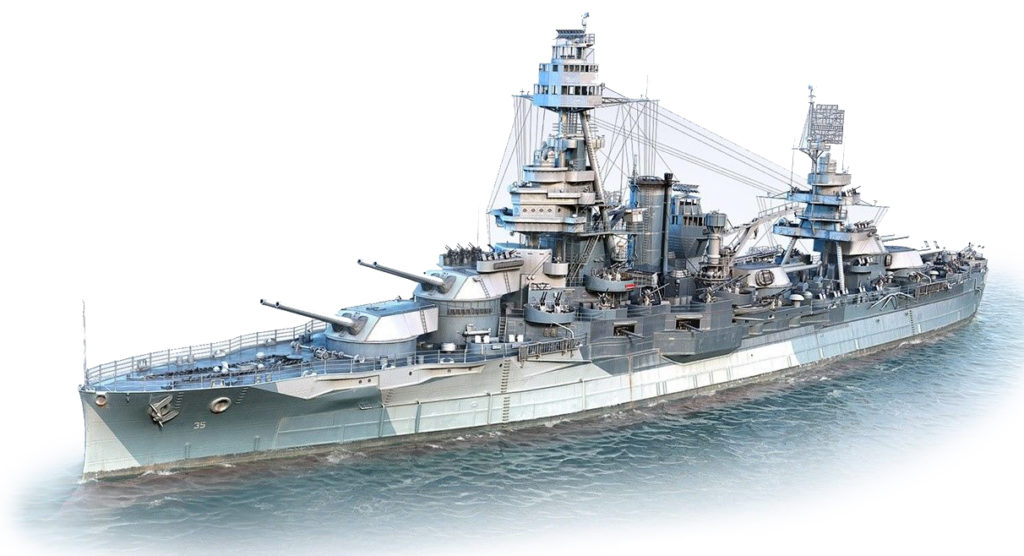
WoW’s rendition of USS Texas
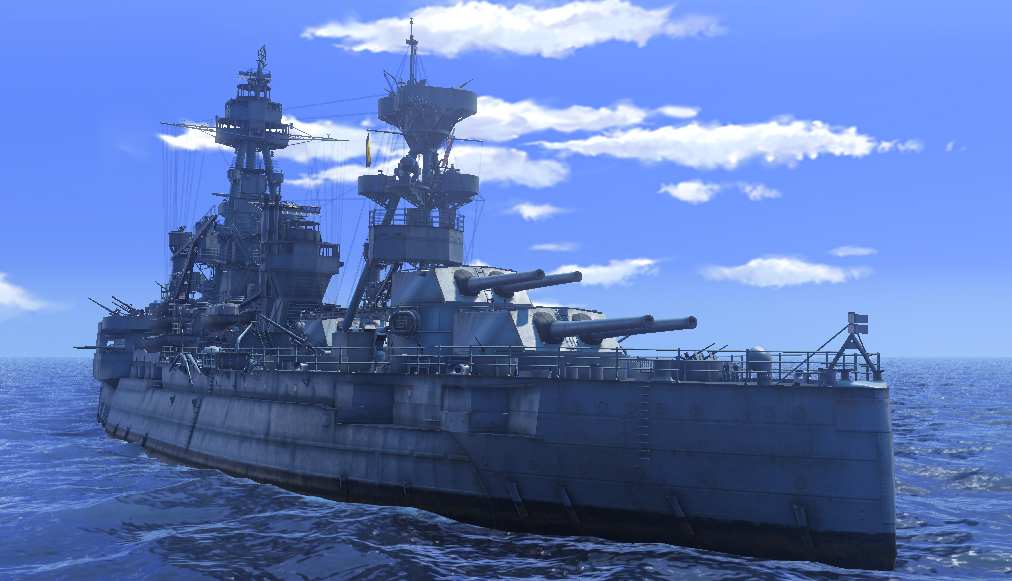
WoW’s renditon of USS New York, stern view
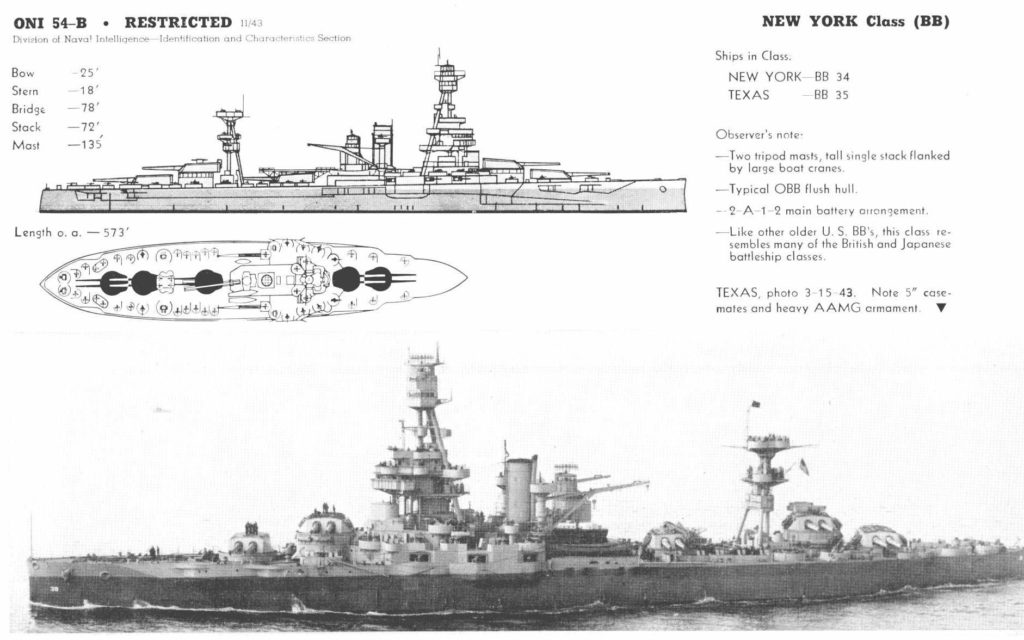
New York class recoignition plate – ONI
Sources/Read More
Dictionary of American Naval Fighting Ships: BB34
BB35 on history.navy.mil.
Friedman, Norman (1985). U.S. Battleships: An Illustrated Design History.
Breyer, Siegfried (1973). Battleships and Battle Cruisers 1905–1970.
Hore, Peter (2006). Battleships of World War I. London: Southwater Books
US Navy, Naval History and Heritage Command (11 May 2009). “USN Ship Types-Battleships”
Friedman, Norman (2011): Naval Weapons of World War One. Seaforth Publishing
archive.org/ full sets of plans
//shipbucket.com/forums/viewtopic.php?f=12&t=8675
naval-encyclopedia.com/ww1/pages/us_navy/us_navy14_18.htm
//en.wikipedia.org/wiki/New_York-class_battleship
battleshiptexas.info
More open source photos of the Texas (Wcommons)
Conway’s all the world fighting ships 1860-1905 and 1906-1921.
ONI general recoignition book – USN
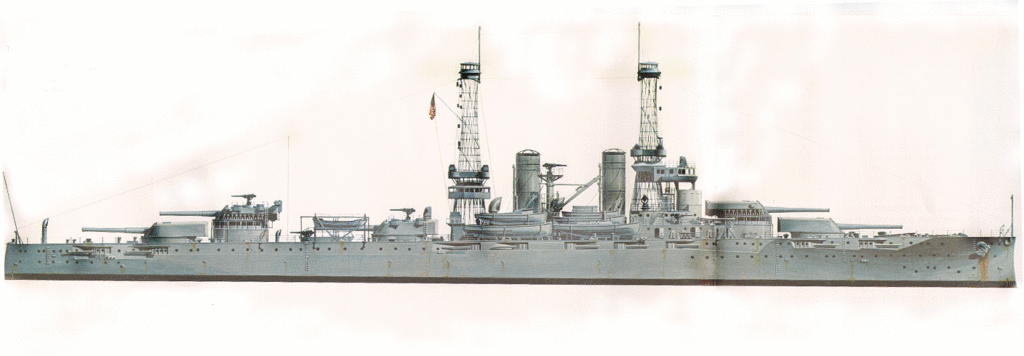
USS Texas 1914 – HD illustration and kit review on maquetland.com
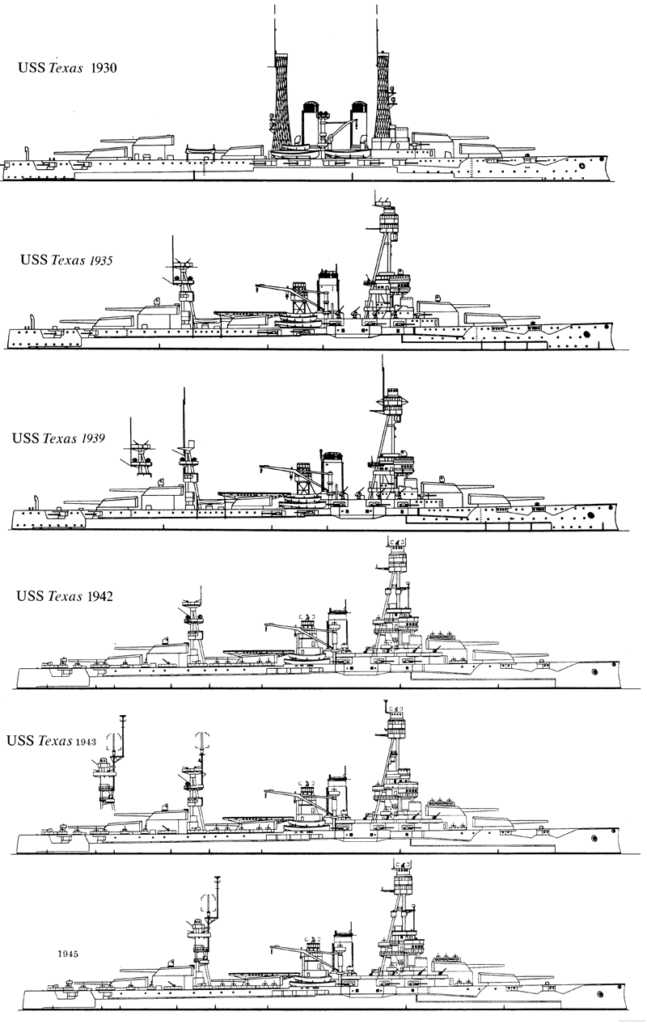
Evolution of the BB34 USS Texas over time, showing her numerous modifications (the blueprints – montage).
Models corner:

Squadron signals – USS Texas overview
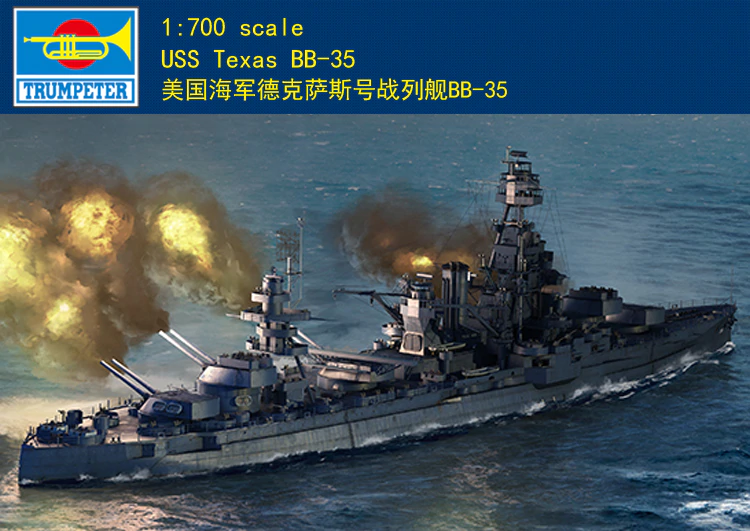
Trumpeter kit of the USS Texas, by far the most famous. It was declined into a 1/700 and 1/350.
//mancavemodeler.com/ships/new-york_700/bb34-700.html
//www.the-blueprints.com/search/texas/ Blueprints fest
Career & Battle records of the New York class
USS Texas happened to be commissioned sooner than the lead ship USS New York, on 12 March 1914, whereas the latter was commissioned on 15 May 1914. They still had three years of peacetime service ahead. Like the rest of the fleet, both battleships participated in the occupation of Veracruz in 1914.
When the great war broke out, USS New York joined Battleship Division 9 (Rear Admiral Hugh Rodman), reinforcing the British Grand Fleet in case the Hochseeflotte sortied. But this never happened. She spotted two U-Boats but there was nothing notable in her career until the end of the war, not in the early interwar. USS Texas received AA guns, a first on USN Battleships, and conducted convoy patrols, in one occasion firing on a German vessel. She also joined BatDiv 9 until the armistice.
Both were refitted in 1926, with new boilers and oil tanks. Their armament was also revised in 1926, 1937, 1939 and in 1942, mostly by discarding the secondary guns and adding AA. In February 1938, USS New York was the first USN Battleship fitted with an XAF RADAR and first duplexer (receiving-emitting) antenna.
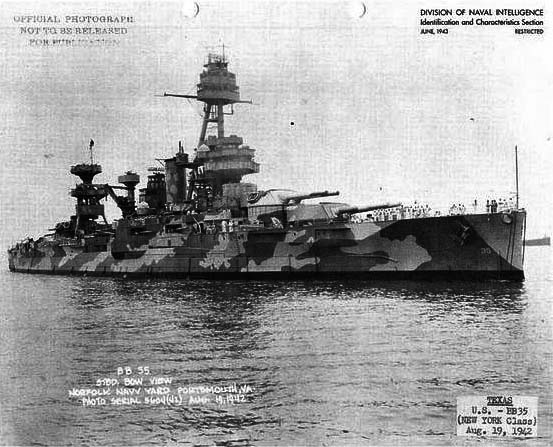
USS Texas camouflage scheme in November 1942 (Operation Torch). Both ships would change livery four times during the war.
USS Texas on her side became one of the first battleships equipped with a catapult to launch an observation seaplane. In her service she alternated between the Atlantic and Pacific waters.
WW2 saw them doing their escort duties after 1939-41 neutrality patrols, until their first serious deployment, covering the landings late 1942 during Operation Torch (Allied invasion of North Africa). Both were among the rare battleships in the Atlantic, therefore not in Pearl Harbor. USS texas would also participate in D-Day and Operation Dragoon in Southern France.
After their service in the Mediterranean and the Atlantic, they were sent in the Pacific after the German capitulation. Both would take part in the hammering force deployed at Iwo Jima and Okinawa, and were struck in 1948.
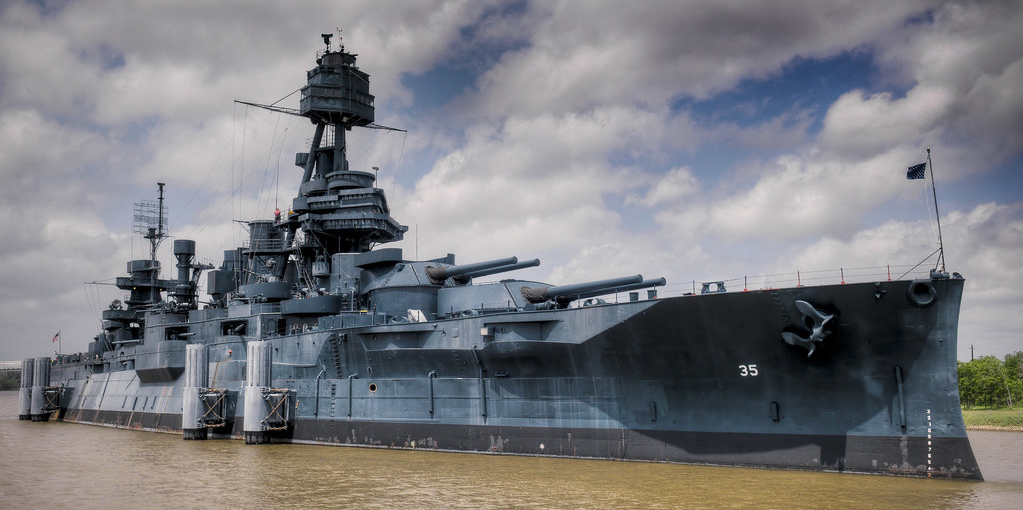
USS Texas at San Jacinto state park, the last great war era dreadnought in existence, wearing the 1945 dark marine blue-grey livery #250 of her decommission.
USS New York
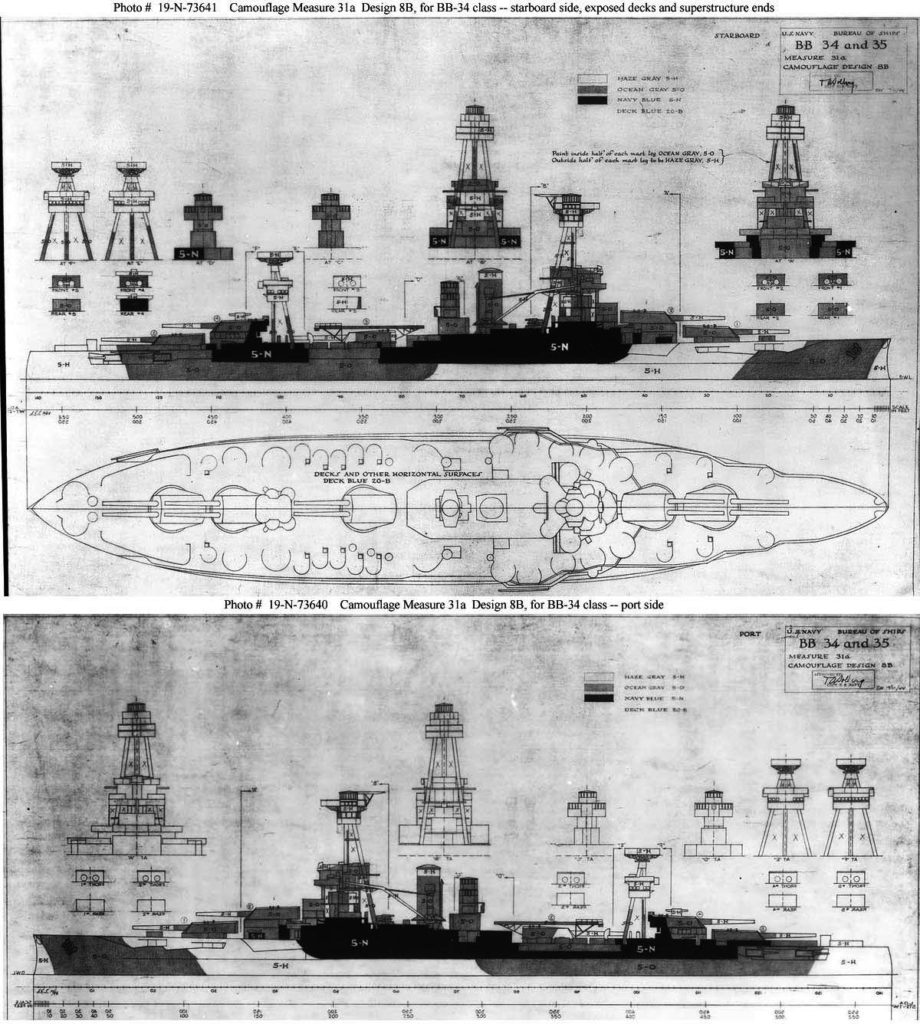
Pattern sheet for the Measure 31a – BB-34 in 1944
Wartime service
Soon after she was commissioned, USS New York departed for Vera Cruz under command of Captain Thomas S. Rodgers. She doubled as flagship for Rear Admiral Frank Friday Fletcher in July 1914, at the head of the fleet occupying and blockading Veracruz, barring the city from Victoriano Huerta. Afterwards, she resumed her shakedown cruise along the East Coast and amde several goodwill visits. By December 1915 several hundred orphans went on board for Christmas in New York City, later a tradition on the ship, earning her the “Christmas Ship” nickname. She departed in January for a serie of fleet exercises on the Atlantic coast.
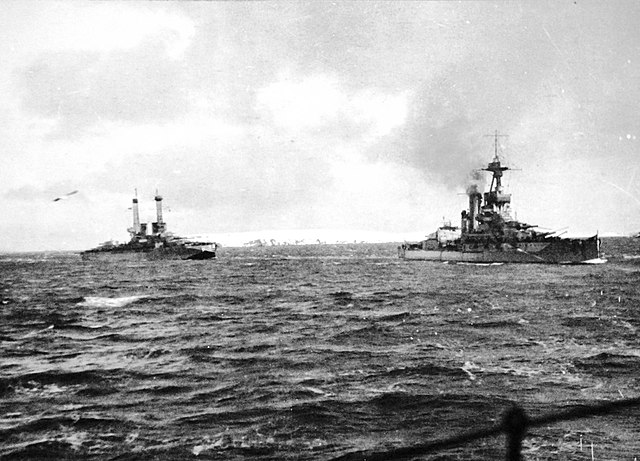
USS New York and HMS iron Duke (foreground), part of the Grand Fleet, 1918. Part of USS New York camouflage can be seen.
When USA entered war, USS New York had a new captain, Edward L. Beach, Sr.. She was the flagship of Battleship Division 9 (BatDiv 9) (Rear Admiral Hugh Rodman), reinforcing the British Grand Fleet at Scapa Flow from December 1917. This unit was attached to the Grand Fleet’s 6th Battle Squadron. Their tasks were blockading the north sea coast and escorting convoys, and in between, gunnery exercises. USS New York was awarded the best score in accuracy, at 93.3% and was consistently rated as “excellent”.
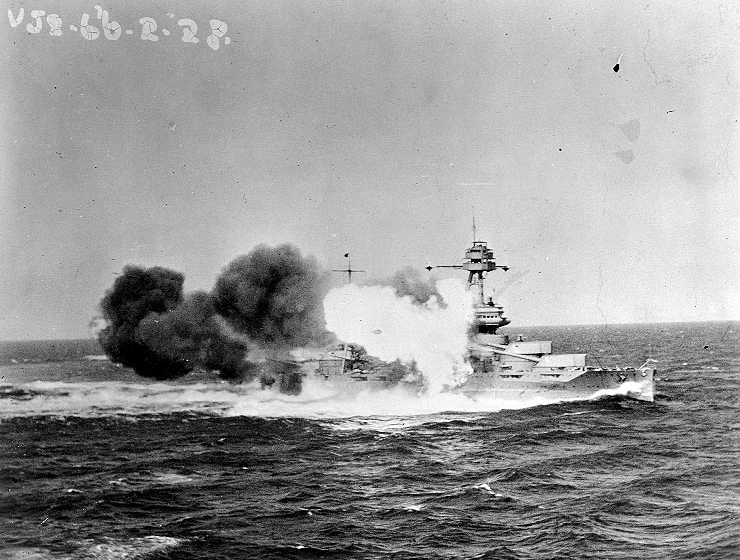
USS Texas gunnery practice in 1928
The paradox was she never fired any shots in anger until the armistice. However during her escort missions, she spotted an U-Boat once, and during another, on 14 October 1918, near the Pentland Firth, she apparently collided on her starboard side and at the stern, breaking off two blades of a propeller. Her speed fell to 12 knots and it appeared to all she hit a massive underwater object which could not be a shipwreck due to the depth here.
The report mentioned a submerged U-boat, ramming its bow probably by accident, and it was assessed that the damage would have been fatal. Postwar German records would correspond to either UB-113 or UB-123. This U-boat “kill” was the only one recorded by Battleship Division Nine. USS New York was later repaired at Rosyth NyD.
When proceeding to the yard, spotters showed torpedo trails, three that passed ahead of the ship. The U-Boat commander incorrectly thought the speed to the about 15-18 knots instead of 12. When drydocked, she was visited several times, by European admiralties, King George V or Hiro-Hito.
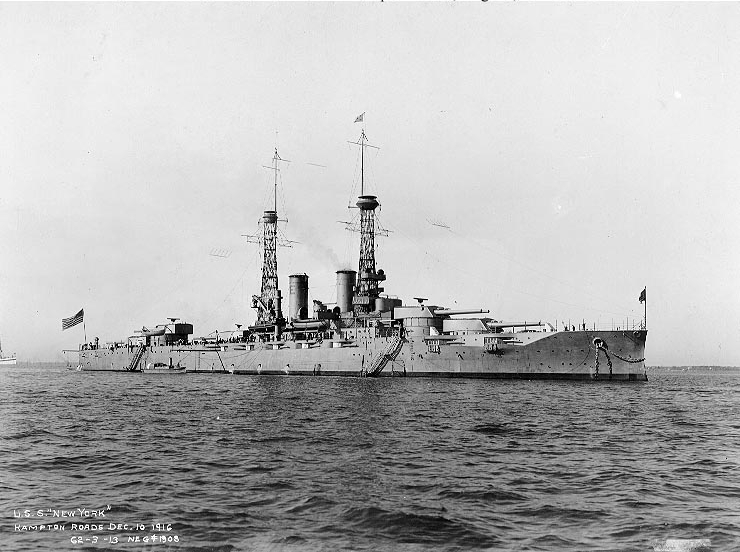
USS New York off Hampton roads, Dec. 1916
The interwar
Video: USS New York in convoy escort WW2 (Critical past). Others.
Just after the surrender of Germany, she returned to the US and came back to Brest, escorting the SS George Washington, carrying President Woodrow Wilson for the Versailles conference. Her interwar years started with service in the Caribbean, and a short refit at Norfolk Navy Yard. She would later cross the Panama canal and head for the Pacific Ocean, joining the newly formed United States Pacific Fleet. She served in the Pacific until the mid-1930s before returning to the east coast.
Meanwhile, in 1926-1928, she underwent a major overhaul at Norfolk NyD. New York and Texas were to see their propulsion and top speed, armor and armament plus fire control and superstructures to be refitted and modernized completely, in accordance to the Washington Treaty. The battleships gained an additional 3,000 long tons of extra protection against aviation and submarines while the AA capabilities were increased. However once back into service in September 1928 it was discovered her anti-torpedo bulges made her less agile at low speeds and she rolled badly.
This curtailed her gunfire accuracy record badly, in particular in rough seas. She teamed with USS Arizona for exercises and departed to San Francisco with USS Pennsylvania, performing AA defense exercises in April 1929. Later the two battleships joined USS Pennsylvania and joined Cuba, and later Hampton Roads. USS New York took part in the Grand Naval Review of 20 May 1937, the King’s Coronation review.
USS New York’s pioneering radar experiment
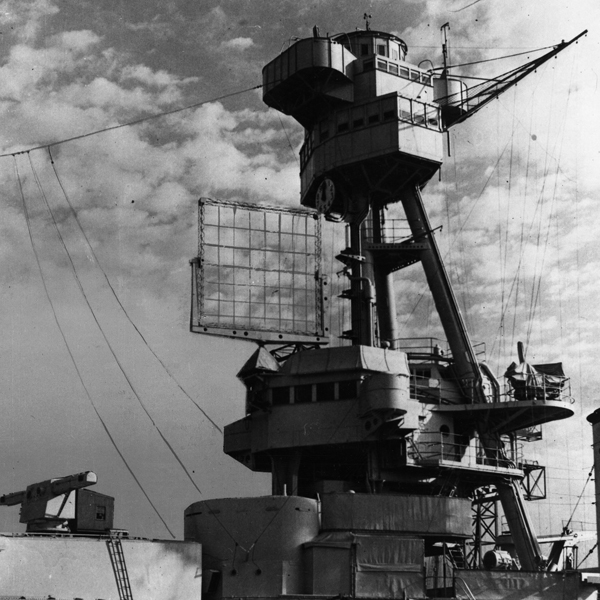
In 1938 the most interesting addition was the XAF radar, an experimental model set resulted from several years’ technical progress by the Naval Research Laboratory (NRL), and also built the transmitter, and receiver. In February it was experimentally installed on a first ship, USS new York. It worked on a 200 MHz or 1.5 meter wavelength, powered at 15 kilowatts. This early radar featured a “bedspring” antenna, 17 feet square.
It scanned the horizon, mounted on the rotating yoke and could elevate and depress to keep the radio signal parallel to the surface even when the ship rolled. The Brewster Aeronautical Corporation fabricated a suitable duralumin structure for it, to by navy grade. It was mounted atop the pilothouse, in place of the large optical rangefinder, moved to the top of the second main forward turret. It really exceeded expectation, in winter manoeuvrers, being able to detect ships at 15 nautical miles and planes at 100 nm. During these exercises for the first time, the radar was used for gunnery practice, with a more precise range and azimuth direction, as served as navigation radar as well in the night and fog, being able to see large obstructions.
The result of the experiment was so good, USS New York captain recommended its installation on all USN aircraft carriers, which was done on the Yorktown class, and other battleships as well like USS California and four cruisers. Radio Corporation of America (RCA) produced the serial CXAM and improved CXAM-1 from mid-1940 to late 1942 as it was made lighter and mounted on cruisers as well, the Brooklyn and St. Louis-class and eventually the battleship USS West Virginia.
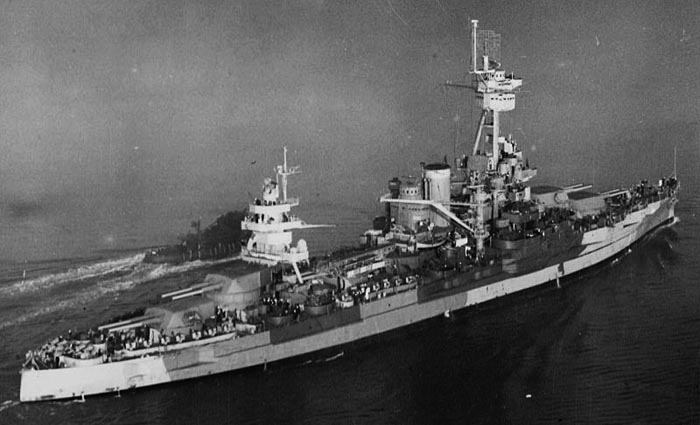
The USS New York in WW2: 1919-41
Prior to WW2, the ageing battleship served as midshipmen training ship and formed new recruits. After the was broke out in September, she served with the Neutrality Patrol squad, around sea lanes of the North Atlantic, and was part of the Atlantic battle squadron; later renamed “United States Atlantic Fleet” for many more month into the war. She also protected a convoy landing troops in Iceland, later used to built intermediate landing strips to Europe, line in Greenland.
In December 1941, she was just refitted when news arrived of the Japanese attack on Pearl Harbor. The overhaul was sped up so that she could scramble to protecte troop and cargo convoys bound to Iceland and Scotland. She would carry out patrols and escort duties during the whole year 1942, being back to Norfolk on 15 September, to be prepared to join the invasion fleet for Operation Torch the next two months.
USS New York Mediterranean campaign

BB.34 shortly after the battle of Casablanca. Notice the two -tone dark blue grey/light grey measure 22 camouflage >.
The battleship had the occasion of firing her main battery for the first time on… French fortifications, ships and other objectives on the coast of Safi, Morocco, together with the cruiser USS Philadelphia and other vessels. This was the Southern Attack Group, where she served as flagship, vovering the assault of the U.S. 9th Infantry Division’s 47th Infantry Regiment.
This force was also covered by the planes of carrier USS Santee. She moved to Casablanca later, notably to deal with more powerful defenses, but arrived when it was all over, the French battleship Jean Bart, still incomplete has just been disabled after a short duel with USS Massachusetts, whereas the Brooklyn and Augusta already dealt wth small Vichy French vessels. When she retired from the area, USS New York has spent 60 shells.
She then performed convoy escort on the line Norfolk-Casablanca until the end of the year. In 1943 however she was refitted to become a main battery and escort training center, a role she held from August 1943, the rest of the year being spent in drydock for a refit. Her training campaign would last until June 1944. She would not participate in D-Day and instead operate with the US Naval Academy until September.
USS New York Pacific campaign
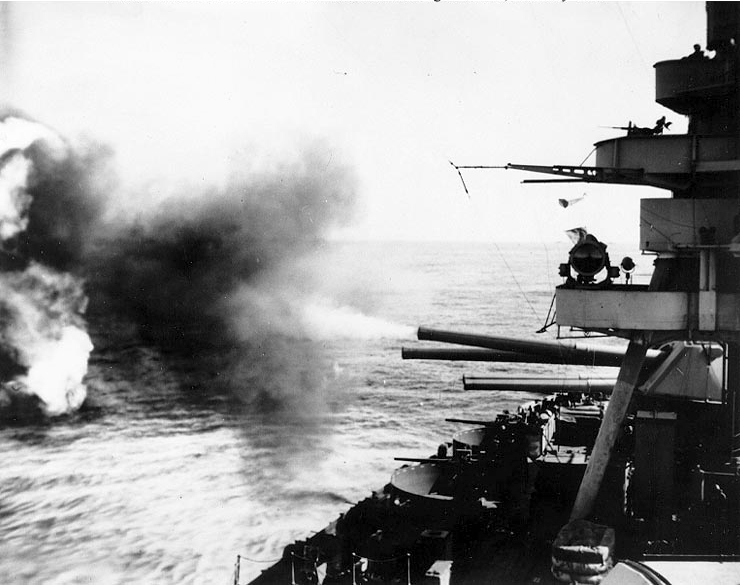
BB34 shelling Iwo Jima in February 1945.
By late 1944 as the situation no longer required massive naval power in the European theater, she passed through the Panama canal and joined the Pacific squadron, transiting by Long Beach, California in December. She trained until late January 1945, joining the Idaho, Tennessee, Nevada, Texas, and Arkansas covering force at Iwo Jima, after repairs to her port screw.
In three days she would spent 6,417 rounds, including 1,037 main rounds on mount Suribashi and other objectives. Apparently one of her main shells stuck the largest Japanese ammunition dump on the Island, provoking an earth-shaking explosion. The she departed to Ulithi on 21 February for supplies and the crew’s rest.
In March, 22, she teamed up with USS Maryland, Colorado, and West Virginia, with Task Force 54, departing from Ulithi to participate in the invasion of Okinawa. She shelling started on 27 March and lasted for 76 days, dealing with major objectives in close coordination with aviation and the troops.
She spent nearly all her main and secondary ammunition (4,159 14-inch rounds) and was struck by a Kamikaze attack 14 April. Damage was light, she lost an observation plane and the catapult. Her artillery has been so widely used that her gun barrels were completely worn out by June and she departed to Pearl Harbor to see them refiled.
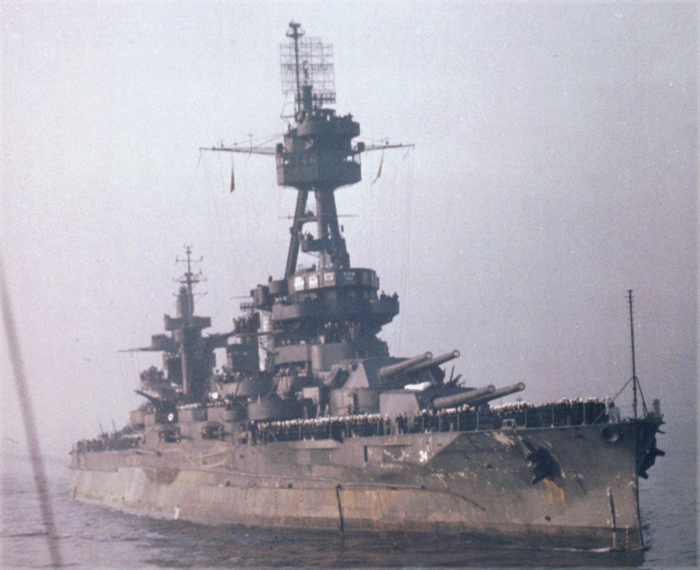
USS New York at Navy Day celebrations, December 1945 in NYC.
She passed through Leyte and was later prepared during the summer for Operation Olympic, the planned the invasion of mainland Japan. The war ended when she was in Pearl Harbor. Instead, she would join in September the Operation Magic Carpet fleet; remebarking tons of veterans in time to participate in New York City to the Navy Day celebrations.
Her end was marked by a flash. She was in Operation Crossroads’ nuclear bomb test fleet anchored in Bikini Atoll, July 1946, badly damaged by the Baker test and the effects were well studied and on 6 July 1948 she was finished of as a target ship by gunfire.
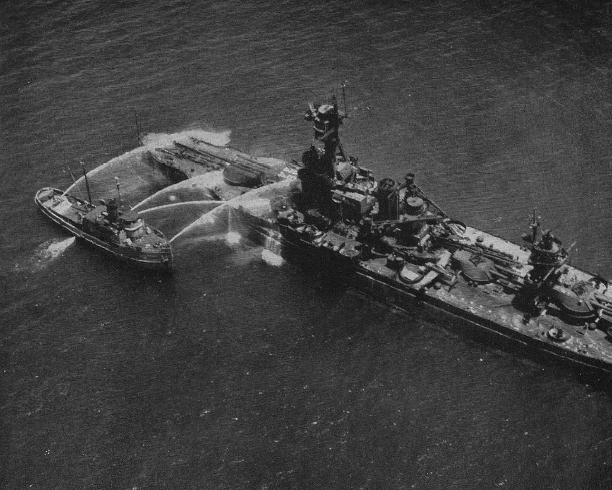
BB34 after Baker test, July 1946 in Bikini Atoll, being washed over to alleviate contamination.
USS Texas
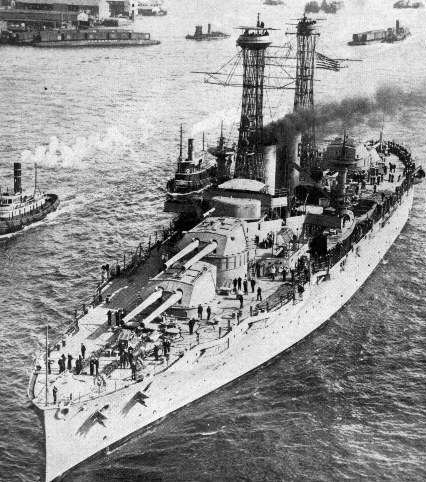
USS Texas Circa 1917, soon after delivery
USS Texas first assignation right after her commission and fitting her fire control equipment at the New York NyD on 24 March 1914, and by order of Pdt. Wilson she was ordered to Mexican waters with the rest of the fleet. This was to pressure the Huerta regime, compounded by later a landing at Veracruz, covered by the battleships. Therefore, USS Texas missed the usual shakedown cruise and post-shakedown settings, which were made later in and out of Hampton Roads.
USS Texas in the great war
USS Texas prior to the war, alternated between the Atlantic fleet and Mexican waters. Setups were made later at NYC Naval Yard until 16 February 1915. USS Texas was fitted two 3-inch (76 mm)/50-caliber guns on top of crane platforms (a solution never repeated as it was not practical for supplying ammo), and fine-tuned its combined use of a gunnery director and rangefinder.
In May she rescued 230 passengers from the SS Ryndam (Holland America Line), badly damaged after a collision at sea. The rest of the year and the next were spent in fleet exercises between New England coast and off the Virginia Capes, spending the winter in the Carribean. The US entered the war in April.
On 26 September 1917, en route to NYC NyD she ran hard aground on Block Island. She was later towed away by tugs and repaired at NY Yard. Part of her secondary artillery was curtailed, and in early 1918 she was back, participating in military simulations out of the York River.
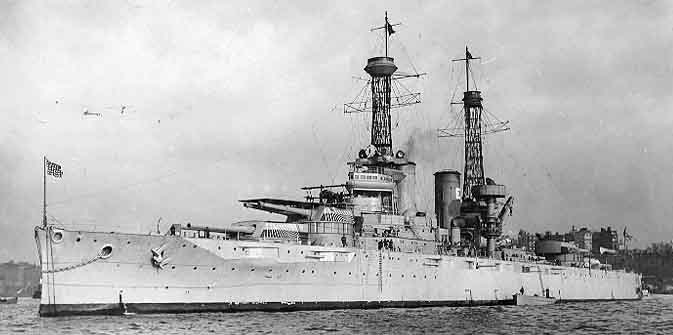
USS Texas off New York City 1919
She departed on 30 January 1918 to join BatDiv 9, the USN component of the 6th Battle Squadron of Britain’s Grand Fleet, Scapa Flow. She alternated between convoy missions and blockade enforcement patrols until the armistice of November. On 25 April, after an escort mission, the Hochseeflotte just had made another sortie, but the American battleship was just too slow to catch up.
Only faster forward vessels saw the German ships at the horizon. She never fired in anger during this conflict, performing exercises and notably protecting American minelayers working on the North Sea Mine Barrage. As the war ended, she accompanied the Grand Fleet to meet the surrendering German Fleet and later BatDiv 9 was dissolved.
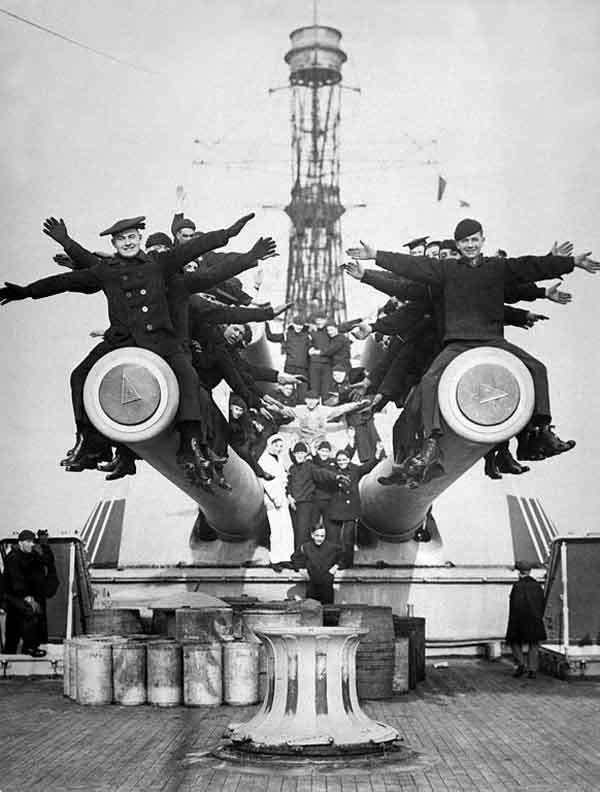
BB-35 crew on top of the forward main turret’s guns
Interwar years
BB-35 was part of the escort that carrier President Wilson to Brest and from there to the Versailles conference. On 10 March 1919, she became the first American battleship to launch an airplane (a Sopwith Camel piloted by Lieutenant Commander Edward O. McDonnell). Previously, the Chester-class cruiser USS Birmingham in 1911 had flow the first plane from any warship. In May, she assisted a Curtiss NC flying boat NC-4 during its Atlantic crossing attempt. Later that year she passed the Panama Canal and joined the Pacific fleet.
She served there 4.5 years, shortly returning in the Atlantic for a training cruise with midshipmen in 1924, sinking as an exercise the incomplete battleship USS Washington (BB-47), according to the 1922 treaty limitations. Her great overhaul started on 31 July 1925 at Norfolk Navy Yard and was completed in 23 November 1926 and she served the eastern seaboard as a flagship until 1927. She would notably carry President Calvin Coolidge to Havana (Cuba) for the Pan-American Conference of 1928.
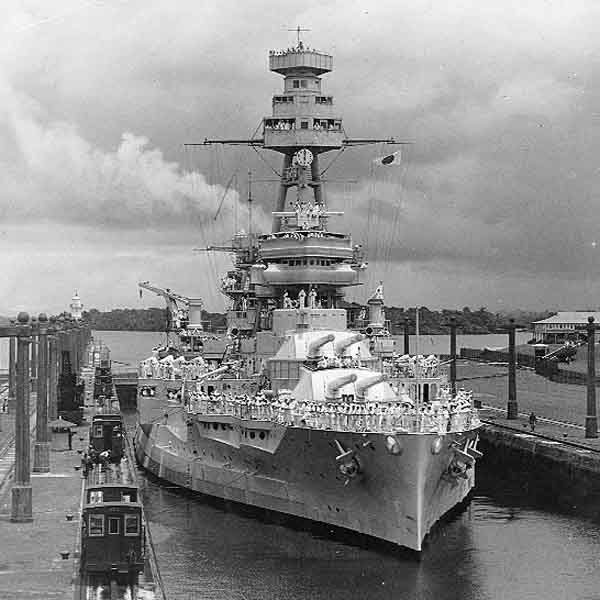
USS Texas through the Panama canal, 1937 (cropped)
After her 1929 overhaul in NY she departed to the Panama Canal zone to cross it to join the Pacific fleet. She would return east, to NY escorting the SS Leviathan into New York and to Europe, carrying the US Delegation to the January 1931 London Conference. She was back to the Pacific and later returned to the Atlantic service from 1934. In 1937 she was the flagship of the Training Detachment, received additional AA. In 1938, the XMZ-radar (385 MHZ). In 1939 she joined the newly formed Atlantic Squadron.
USS Texas in WW2: 1939-41
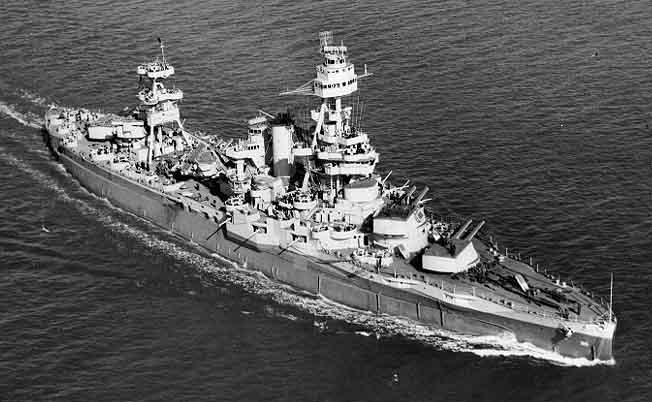
USS Texas off Norfolk, Virginia, 1943
Frm September 1939, USS Texas started her Neutrality Patrol duty off the Atlantic coast and later in 1941, convoy duties in relation to Lend-Lease shipping to the United Kingdom. When February 1941 started the US 1st Marine Division was activated onboard BB-34, Admiral Ernest J. King hoisted his flag as to make USS Texas the flagship of the Atlantic Fleet. While on Neutrality Patrol the German submarine U-203 reported firing her torpedoes at BB-35 but missed.
After Pearl Harbor, USS Texas was located at Casco Bay in the Maine, with in the north Atlantic, anchored to to leave the crew having a rest and resupply. She has been detached for three month off Newfoundland, at Argentia. She returned there and stayed at this post until January 1942, escorting a convoy to UK and then patrolling off Iceland until March 1941, before getting home. For the six months, she went on in convoy-escort along the Atlantic. She for example carried Marines to Panama, escorted troops to Freetown in Sierra Leone, but United Kingdom was the more common destination.
1942-44 Mediterranean campaigns
Operation Torch
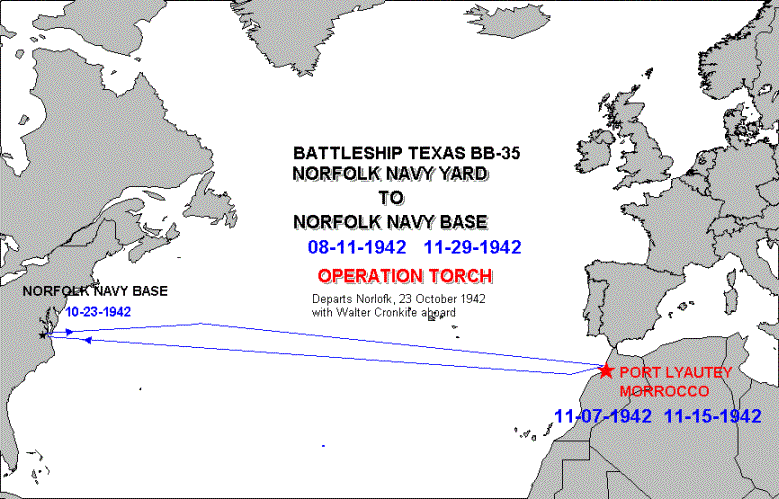
The trip of USS Texas at Port Lyautey, November 1942. Credits battleshiptexas.info
In September 1942 she was mobilize for the first great deployment of US Forces in the Europan theater: The landings in French-Vichy held North African coast. On 23 October 1942, USS Texas was part of Task Group 34.8 (TG 34.8), Northern Attack Group of the Operation, targeting Port Lyautey in French Morocco. Troops landed at the village of Mehedia on 8 November with no resistance. USS Texas megaphones, installed for the accoasion, broadcasted at noon Eisenhower’s “Voice of Freedom” broadcast for the French troops not to fire.
There was no prelanding bombardments, however early in the afternoon the Army requested the ship firing at a Vichy Army ammunition dump, and later another the folloing day. Cease fire intervened on 11 November. However Vichy French reinforcements arrived from the East and the Army requested an active rtillery support. USS Texas fired 214 HE shells, effectively halting the column in its track and dispersing it. Some of her most experienced crewmen ald disembarked to try to recover scuttled or damaged French ships in Port Lyautey.
By 16 November BB-35 went back home with the USS Savannah, Sangamon, Kennebec, four transports, and seven destroyers, having accomplish her mission, with Walter Cronkite was on board, reporting on the operations, which boosted his career as he used the onboard observation plane to report the news first. USS Texas spent Christmas on the eastern coast while the crew had a leave, and returned in January to the end of 1943 making ecort duties, notably covering troopships to North Africa and back.

Profile of USS Texas in November 1942 (measure 12) – credits battleshiptexas.org
Operation Dragoon
This happened after the landing in Normandy in June (see later). In August, USS Texas was part of the covering invasion force. She was repaired at Plymouth, resupplied, then departed Belfast for Gibraltar and headed for Oran in Algeria to meet the rest of the fleet and then Tarento, and back west meeting three French destroyers. She was in front of the French Riviera’s St Tropez on 14 August, arriving by night, banding with USS Nevada and the cruiser USS Philadelphia.
Bombardment started at noon. She silence a battery of five 15 cm guns but overall the resistance was less than expected and troops progressed rapidly. It was so fast, that after a day, the range was not sufficient to cover the troops and the Texas left for Palermo, Sicily, and then headed west, to New York where she arrived in September 1944.
Operation Overlord
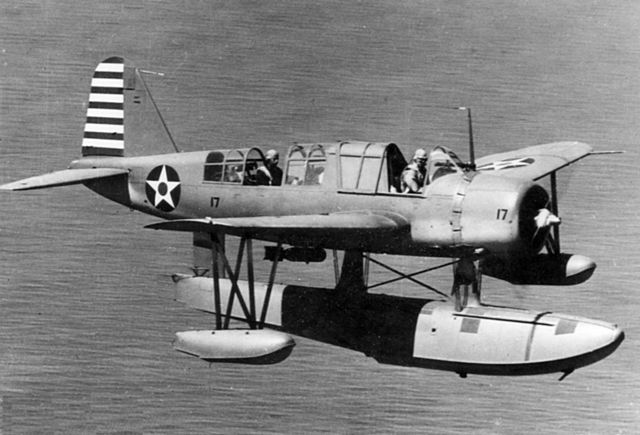
In early 1944, preparation for Operation Overlord were going well. By 22 April US Texas was anchored on the clyde eastuary to train to operate with the Royal Navy. She learned how to coordinate fire in specific objectives with the HMS Ramillies and Rodney, correcting her fire using RAF spotters observations. Later she joined Nevada and Arkansas to Belfast Lough, Northern Ireland for extra preparation, notably the observation plane OS2U Kinfisher and catapult were removed. The same happened to the cruisers Augusta, Quincy, and Tuscaloosa. Planes and pilots were integrated into a mixed RAF-USN unit called VOS-7. All USN pilots learned to fly observation Spitfires, instead of their own plane because of the Luftwaffe’s threat.
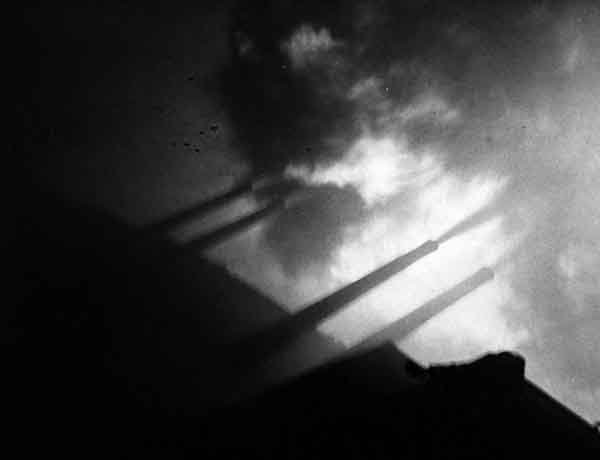
BB-35 at Omaha Beach, guns blazing.
Onboard Texas and other ships were installed a jam radio-guided missiles detection system, which as thoroughly tested. Other coordination drills were made as well. At one occasion, General Eisenhower came on board. Eventually, USS Texas became the Bombardment Force Flagship for Omaha Beach, with the responsibility of coordinating the entire artillery support, of all ships present, to the whole sector.
Pointe du Hoc assault cover
The operation was postponed on 4 June due to execrable weather condition. The weather improved and the fleet sailed again on 6 june 1944. BB-35 arrive to take her position at noon, and from then on until the end of the day, actively supported the US 29th Infantry Division and 2nd Ranger Battalion trying to get to Pointe du Hoc and the reinforcing 5th Ranger Battalion.
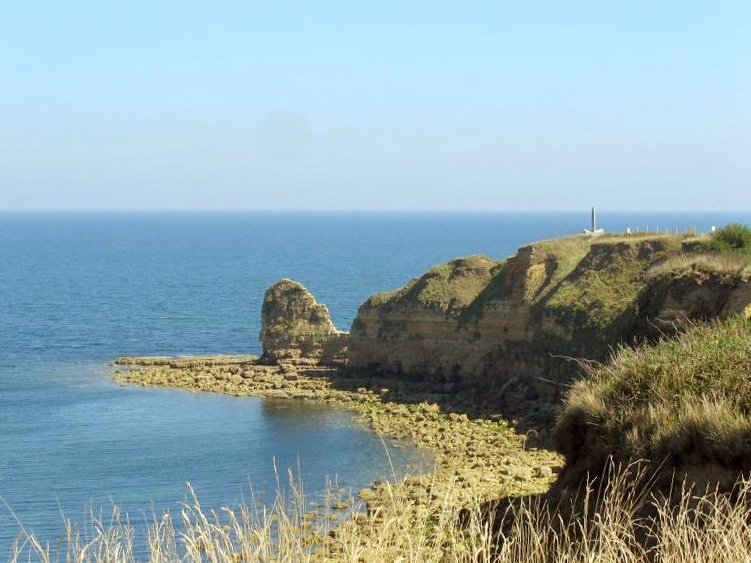
Pointe du Hoc, closing Omaha Beach. There were enfilade guns targeting the whole beach that needed to be taken out. The Rangers were given this difficult task, closely supported by USS texas.
Texas also bombarded the whole Atlantic wall fortification lines along the coast in coordination with HMS Glasgow on western sector, Arkansas and George Leygues in the east sector, plus the destroyers USS Frankford, McCook, Carmick, Doyle, Emmons, Baldwin, Harding, Satterlee, Thompson, and HMS Tanatside, Talybont and Melbreak.
German resistance proved deadly at Omaha, so much so that at midday, 12:23, USS Texas was requested by the desperate, pinned down US Infantry to close to 3,000 yd (2,700 m) to fire her main guns almost point-blank to deal with small objectives, at exit D-1 in front of Vierville, seadling with machine guns nests and snipers position transmitted by the troops. On the evening her last shot were to destroy a FLAK battery.
On 7 June, she ordered two LCVP, filled them with ammo, and sent them to supply the immobilized Ranger battalion at Pointe Du Hoc, short of ammunitions, and from then on would provide fire support to allow their progression. The landing crafts would bring back 35 wounded Rangers to Texas to be care for by the onboard medical team. The battleship became the de facto operating base for the elite Rangers during the battle, notably to take Formigny. On the 8 and 9 she dealt with German batteries at Isigny and Trévières.
Omaha Beach: long range Beachhead cover
Short of shells, USS departed to Plymouth to resupply and was back on 11 June, but at that stage, the operation was a success and a deep bridgehead was secured. As troop progressed beyond the maximal range of the ship, the crew of BB-35 filled the torpedo blister opposite to the shore, enough for safe list of two degrees, artificially increasing the main guns range to a few extra kilomerers. She was back in UK on 18 June.
Battle of Cherbourg
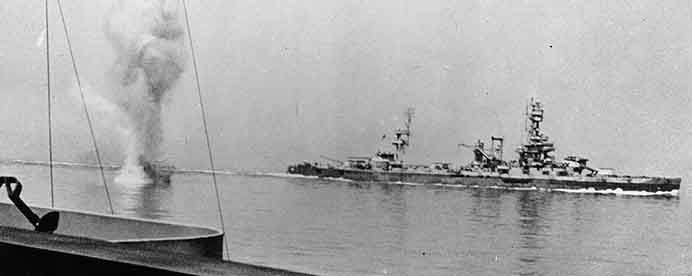
The battle of Cherbourg – June 1944, splash of German (ex-French WW1 vintage) 240 mm guns.
The second phase of the campaign for USS texas, was to deal with the port of Cherbourg, the only port nearby needed to allow larger ships to disembark troops and materials necessary for the exploitation of the allied forces deeper in Normandy. The German-held ports had substantial defences, notably a battery of heavy guns. This was trusted on USS Texas, assisted by USS Arkansas, four cruisers and eleven destroyers.
During the bombardment which started at 12:33 US Troops of the VII Corps tried to take the city by the rear. The operation took place on 25 June. By the end of the day, the 24 cm (9 in) guns were shut, but BB-35 took two hits in the process, one which failed to explode in the Warrant Officer M.A. Clark, another destroyed the conning tower periscope and wrecked the pilot house (seven injured, one dead), but at 13:35 it was over, with a direct hit in the German battery.
USS Texas’s Pacific campaign
USS texas stayed 36-day in repairs, with her main guns barrels replaced and additional AA added (forty 20 mm guns in all). She made a quick retraining cruise, departed Maine for the Panama Canal and tto the Pacific, stopping at Long Beach. She prceeded to Oahu, spent Christmas 1944 at Pearl Harbor. After a month of training she arrived at Ulithi Atoll in January, and then departed on 10 February 1945 to the Mariana Islands. She trained here for two days and then headed for Iwo Jima, arriving on 16 February.
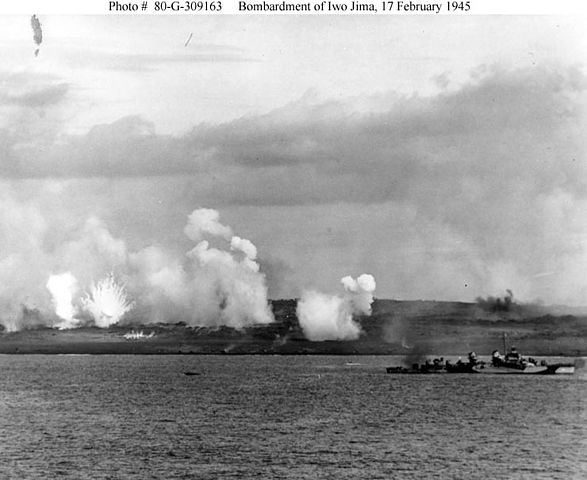
Iwo Jima bombardment seen from USS Texas
During three days she pounded the Japanese defensive positions in preparation for the landing. She would cover the progression inland of three Marine Corps Divisions. She then switched to close gunfire support, the “On-call fire” which went on until 21 February.
She headed for the Volcano Islands on 7 March 1945 then back to Ulithi Atoll, preparing the next invasion of Okinawa, called Operation Iceberg. Inerted in TF 54, on 21 March, she arrived reached the Ryukyu Islands on 26 march, then Okinawa, took her positions and like USS New York, would provide from there an uninterrupted daily artillery support, starting with prelanding bombardment and six days landing support, until 1 April. She was hit by several kamikaze, but all missed.
Artillery support on demand would go on for almost two months. There were more jkamikaze attacks, US Texas claiming a kill, claiming three assist kills. She headed then for the Philippines on 14 May. She would stay here until 15 August, and the Japanese capitulation.
Fate of BB-34: The last ww1 dreadnought
Amazingly for such old vessel, veteran of two wars, USS texas is still wth us today. She can be visited at the San Jacinto Battleground State Park, the last dreadnought in existence. This story is a whole league in itself. Indeed, USS texas after the war participated in Operation Magic Carpet, then, the Navy Days celebrations, and placed in june 1946 in reserve at Baltimore, Maryland; SHE WAS DECOMMISIONED. But on 17 April 1947 Texans made the project established the Texas Commission to take care of the ship with the long term project of turning her into a memorial…

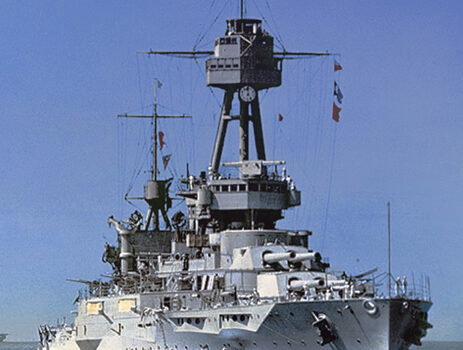
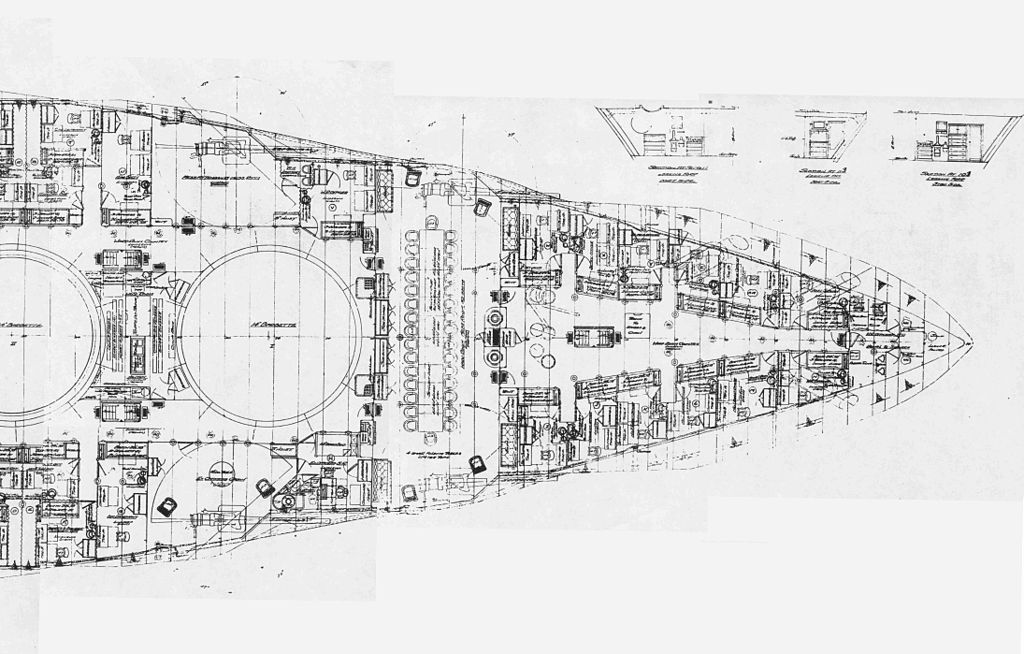
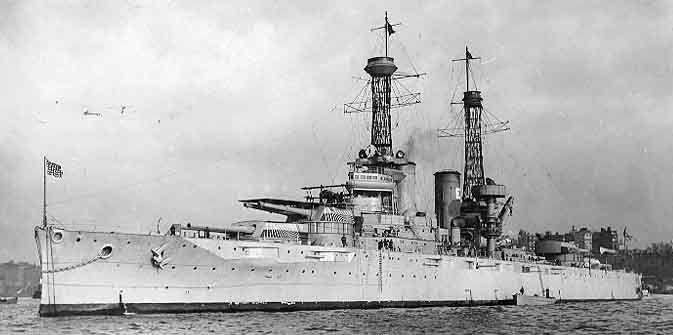


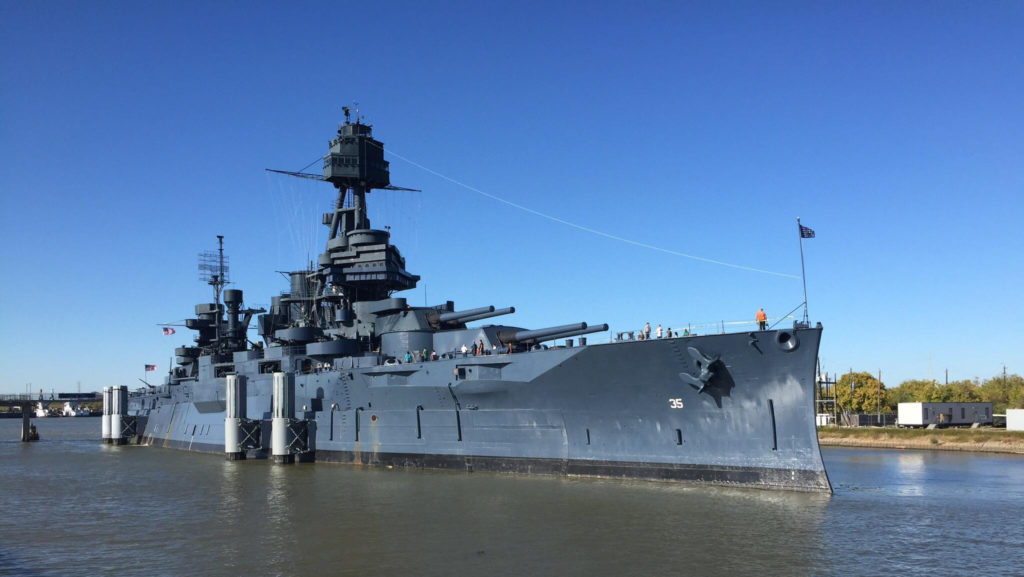
 Latest Facebook Entry -
Latest Facebook Entry -  X(Tweeter) Naval Encyclopedia's deck archive
X(Tweeter) Naval Encyclopedia's deck archive Instagram (@navalencyc)
Instagram (@navalencyc)





 French Navy
French Navy Royal Navy
Royal Navy Russian Navy
Russian Navy Armada Espanola
Armada Espanola Austrian Navy
Austrian Navy K.u.K. Kriegsmarine
K.u.K. Kriegsmarine Dansk Marine
Dansk Marine Nautiko Hellenon
Nautiko Hellenon Koninklije Marine 1870
Koninklije Marine 1870 Marinha do Brasil
Marinha do Brasil Osmanlı Donanması
Osmanlı Donanması Marina Do Peru
Marina Do Peru Marinha do Portugal
Marinha do Portugal Regia Marina 1870
Regia Marina 1870 Nihhon Kaigun 1870
Nihhon Kaigun 1870 Preußische Marine 1870
Preußische Marine 1870 Russkiy Flot 1870
Russkiy Flot 1870 Svenska marinen
Svenska marinen Søværnet
Søværnet Union Navy
Union Navy Confederate Navy
Confederate Navy Armada de Argentina
Armada de Argentina Imperial Chinese Navy
Imperial Chinese Navy Marinha do Portugal
Marinha do Portugal Mexico
Mexico Kaiserliche Marine
Kaiserliche Marine 1898 US Navy
1898 US Navy Sovietskiy Flot
Sovietskiy Flot Royal Canadian Navy
Royal Canadian Navy Royal Australian Navy
Royal Australian Navy RNZN Fleet
RNZN Fleet Chinese Navy 1937
Chinese Navy 1937 Kriegsmarine
Kriegsmarine Chilean Navy
Chilean Navy Danish Navy
Danish Navy Finnish Navy
Finnish Navy Hellenic Navy
Hellenic Navy Polish Navy
Polish Navy Romanian Navy
Romanian Navy Turkish Navy
Turkish Navy Royal Yugoslav Navy
Royal Yugoslav Navy Royal Thai Navy
Royal Thai Navy Minor Navies
Minor Navies Albania
Albania Austria
Austria Belgium
Belgium Columbia
Columbia Costa Rica
Costa Rica Cuba
Cuba Czechoslovakia
Czechoslovakia Dominican Republic
Dominican Republic Haiti
Haiti Hungary
Hungary Honduras
Honduras Estonia
Estonia Iceland
Iceland Eire
Eire Equador
Equador Iran
Iran Iraq
Iraq Latvia
Latvia Liberia
Liberia Lithuania
Lithuania Mandchukuo
Mandchukuo Morocco
Morocco Nicaragua
Nicaragua Persia
Persia San Salvador
San Salvador Sarawak
Sarawak Uruguay
Uruguay Venezuela
Venezuela Zanzibar
Zanzibar Warsaw Pact Navies
Warsaw Pact Navies Bulgaria
Bulgaria Hungary
Hungary

 Bundesmarine
Bundesmarine Dutch Navy
Dutch Navy Hellenic Navy
Hellenic Navy Marina Militare
Marina Militare Yugoslav Navy
Yugoslav Navy Chinese Navy
Chinese Navy Indian Navy
Indian Navy Indonesian Navy
Indonesian Navy JMSDF
JMSDF North Korean Navy
North Korean Navy Pakistani Navy
Pakistani Navy Philippines Navy
Philippines Navy ROKN
ROKN Rep. of Singapore Navy
Rep. of Singapore Navy Taiwanese Navy
Taiwanese Navy IDF Navy
IDF Navy Saudi Navy
Saudi Navy Royal New Zealand Navy
Royal New Zealand Navy Egyptian Navy
Egyptian Navy South African Navy
South African Navy






























 Ukrainian Navy
Ukrainian Navy dbodesign
dbodesign